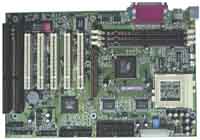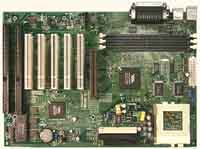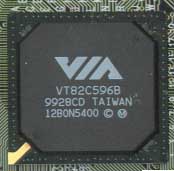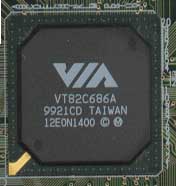
Original Link: https://www.anandtech.com/show/370
Motherboard Head to Head: Epox MVP3G2 vs Tyan S1598
by Anand Lal Shimpi on September 9, 1999 10:06 PM EST- Posted in
- Motherboards
For over two years now AnandTech has been reporting on the good and the bad of motherboards, covering close to 200 motherboards and rating them based on a number of set standards. But a single motherboard review can only go so far as to give you, the reader, a general idea of whether or not the board deserves your consideration, a much more broad roundup is necessary for a true buying decision. At the same time, a large roundup of 10 or more motherboards often removes the closer comparisons we'd like to make between individual boards due to time and length constraints. The solution? A head to head comparison of a select few motherboards that are similar in functionality but differ to the point that there can be only one winner with the remaining competitor(s) emerging as the sore loser.
The basic premise of these comparisons is that ultimately, when you are looking to purchase a motherboard the final decision comes down to which motherboard out of a select group is the best for your needs. So without further ado, let's get to the first Head to Head comparison on AnandTech, taking place in the Super7 arena we have the Epox MVP3G2 and the Tyan S1598.
Epox MVP3G2 Review | Tyan Trinity S1598 Review
Introduction
The super7 motherboard market hasn't exactly been saturated with good or even decent quality motherboards since the advent of the standard last year. The reasons for this lack of enthusiasm for the standard on the part of motherboard manufacturers stems from a number of concerns. At first, most motherboard manufacturers were very skeptical as to how long the standard would last with AMD as its sole supporter (at the time AMD didn't have the best record of delivering on their promises on time). Other concerns included upsetting the microprocessor giant, Intel, by supporting the production of more Socket-7 motherboards after Intel had officially abandoned the standard in favor of the Pentium II's 242-pin Slot-1 connector. The end result was that the majority of manufacturer did not support the standard, and those that did at the launch of the first Super7 processor, the AMD K6-2, weren't of the best in quality or reliability compared to their LX and later, their BX counterparts.
Finally, well over a year later, motherboard manufacturers are starting to realize that maybe AMD does have something on their hands with the K6-2 and K6-III processors, and maybe they should get on the bandwagon. After all, as the old adage goes, it's better late than never. Unfortunately for many manufacturers, the "never" route will be the one most traveled, but what about those manufacturers that chose to support the standard? Among those are the two we are taking a look at today, Epox and Tyan.
Corporate Background Information
Epox has supported the Super7 motherboard market since the start with some of the first MVP3 boards ever to hit the market (MVP3C-M and MVP3E-M). Not only was Epox among the first to support the Super7 standard, they were also among the first to do so with some style as all of their Super7 motherboards have been praised by users and reviewers alike.
Tyan has been pro-Intel for quite some time, and their presence in the Super7 market has been limited. Their first Super7 product came under the Trinity name and boasted a few neat options, however the success of the model wasn't as great as Tyan is used to with their other workstation/server motherboard products.
Both Epox and Tyan were founded in 1989 the only difference being that Epox started out manufacturing x86 motherboards while Tyan focused primarily on manufacturing Sun compatible systems prior to their public entrance in 1991. Of the two companies Tyan is the larger company in this Head to Head however with both having had equal amounts of time to establish themselves, which comes out on top when the playing field is leveled and the only basis for competition are their products alone?
Let's start off with a quick motherboard feature comparison:
| Epox MVP3G2 | Tyan Trinity S1598 | |
| CPU Interface | Super Socket-7 | Super Socket-7 |
| Chipset | VIA MVP3 | VIA MVP3 |
| L2 Cache | 1024KB (512KB/2MB optional) | 1024KB (512KB/2MB optional) |
| Form Factor | ATX - 8" x 12" | ATX - 8.3" x 12" |
| Bus Speeds | 66 / 68 / 75 / 83 / 95 100 / 112 / 124 / 133 |
66 / 75 / 83 / 95 / 100 |
| Clock Multipliers | 1.5x - 5.5x | 1.5x - 5.5x |
| Voltages Supported | 1.8v - 3.2v (in 0.1v increments) | 1.3v - 3.5v (0.1v increments) |
| Memory Slots | 3 168pin DIMM Slots | 3 168pin DIMM Slots |
| Expansion Slots | 0 AMR 1 AGP Slot 5 PCI Slots (1 Full Length) 2 ISA Slots (1 Shared / 2 Full Length) |
0 AMR 1 AGP Slot 5 PCI Slots (5 Full Length) 2 ISA Slots (1 Shared / 1 Full Length) |
| BIOS | Award BIOS 4.51PG | Award BIOS 4.51PG |
| AnandTech MB Rating | 85/B | 87/B |
Click Here to learn about AnandTech's Motherboard Testing Methodology.
Epox MVP3G2
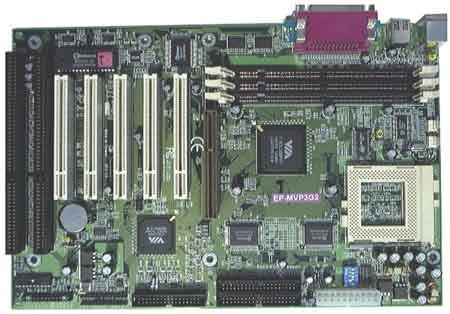
Tyan Trinity S1598
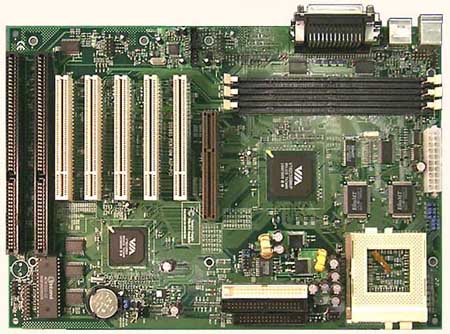
Layout - Advantage Epox
Just like our motherboard reviews, our Head to Head comparison starts off with a comparison of the layouts of the two motherboards. Both boards are available in a standard ATX form factor with the Epox G2 measuring in at 8" x 12" and the Tyan S1598 coming in around 0.3" longer but with the same width. While that extra 0.3" doesn't seem to be much on paper, it does translate into a startling disadvantage for Tyan in the layout department. By placing the Socket-7 connector in the bottom right hand corner of the motherboard, cramped ATX cases either won't accept the motherboard with a larger (1.25"+) heatsink on the CPU or they will allow for the installation of the motherboard but doing so will render one or two 3.5" storage bays unusable.
| Although Epox has a similar placement for the Socket-7 connector, the overall shorter length of the motherboard and the fact that the Socket-7 connector is pushed up over an inch away from the edge of the motherboard allow it to survive in situations where the S1598 wouldn't be able to fit. The placement of the Socket-7 connector is the nail in the coffin for Tyan in terms of the layout of their S1598, however the board does hold a couple of small layout advantages over the Epox that are worth noting. |
Since both boards boast the same 5/2/1 (PCI/ISA/AGP) expansion slot configuration as well as the same 3 DIMM slots for memory expansion (located in the same area on both motherboards), the only other point for layout comparison is with the expansion slots themselves. In this respect, Tyan comes away victorious as all of the PCI slots on the S1598 are capable of accepting full length cards as is a minimum of one of the ISA slots. The extra 0.3" on the S1598 allowed Tyan to place the two IDE connectors and the floppy drive connector in one vertical line whereas the G2's layout has the floppy connector along side the first IDE connector therefore obstructing the installation of full length PCI cards in the first two slots.
The positioning of the ATX power supply connector on the S1598 is also more ideal than that on the G2, as you must stretch the cables across the entire length of the motherboard in order to reach the connector on the latter while Tyan placed theirs on the far right hand edge of the board, naturally located near the ATX power supply in your case.
| Unfortunately for Tyan, those last two points weren't strong enough to make up for the major flaw in the S1598's layout, the positioning of the Socket-7 connector and the overall length of the motherboard in comparison to the Epox. |
Memory/L2 Cache - Draw
Memory compatibility has been a prominent yet overlooked issue in the Super7 motherboard industry and has been the source of quite a few stability related issues, how well did our two boards stack up in the memory compatibility tests? For starters, neither board would even so much as boot with a 256MB DIMM installed in any of the three DIMM slots. We tried three different 256MB SDRAM sticks, the first featured NEC chips, the second featured Samsung and the third was a Kingston module that featured higher density NEC chips. Just like the 256MB modules, Registered DIMMs wouldn't work either, this seems like an issue dealing with the MVP3 North Bridge rather than the motherboards themselves as we have yet to see a Super7 motherboard compatible with either of those two memory types. Keep in mind that neither board supported a cacheable memory area greater than 254MB and thus the use of 256MB DIMMs wouldn't be that advantageous with either of these two boards.
Both the Epox G2 and the Tyan S1598 made use of the same 4ns Winbond L2 cache chips totaling 1MB of on-board cache. The 4ns modules, in theory, allow for operation at up to 250MHz however a number of factors obviously keep that from becoming reality (otherwise the K6-2/3 would become the ideal overclocker's platform). One of those limiting factors is the 8ns Tag RAM present on both boards which is theoretically capable of operation at frequencies up to and including 125MHz, however as we've come to know and love from the RAM industry, chip ratings are not always indicative of true limitations. The Tag RAM present on both motherboards is a 32Kx8 chip manufactured by SBT for the G2 and EliteMT for the S1598, there is no discernable difference between the two manufacturers in terms of quality.
The two boards also place their DIMM slots in identical locations and nearly equal distances away from the VIA MVP3 North Bridge controller making stability issues due to trace lengths a difficult comparison to make between the two motherboards. Overall, the memory/L2 cache comparison between the two competitors comes up as a draw.
Chipset Configuration - Advantage Epox
The versatility of the MVP3 chipset comes from VIA's North/South bridge setup, allowing for the matching up of a single North Bridge controller with different optional South Bridge chips. This remains one of the biggest differences between the Epox and the Tyan boards compared here. First let's take a look at the Epox's configuration. The G2 makes use of the VT82C598MVP North Bridge controller, Revision CE and is paired up with the VT82C596B South Bridge controller. The North Bridge chip brings the basic functionality of the MVP3 chipset to the G2 such as support for AGP 2X, SDRAM support, and other such features that are standard to all MVP3 based motherboards.
| The 596B South Bridge breaks off from the standard 596 South Bridge by adding support for the Ultra ATA 66 specification, one of the major selling points for the G2 over previous MVP3 boards manufactured by Epox. Other than that sole difference, the North/South bridge combination on the G2 is fairly standard for a MVP3 based motherboard. |
|
The Tyan board we received featured the CD revision of the VT82C598AT North Bridge, the difference between the two North Bridges will be explained a little later. This North Bridge is identical to the one featured on the Epox G2 and offers performance equal to that of the VT82C598MVP, once again, we'll explain the real differences between the two chips a little later.
| The main difference between the S1598 and the G2 is the South Bridge, with the S1598 boasting the new and more feature packed VT82C686A aka the MVP3 Super South Bridge. The 686A integrates the same Ultra ATA 66 functionality into the South Bridge however it also brings integrated hardware monitoring support, and support for a single AMR slot and thus on-board Audio/Telephony codecs, all in a chip that is pin compatible with the cheaper 596B South Bridge. |
|
Here's where the problem is, although Tyan takes advantage of the integrated hardware monitoring features of the 686A, they do not take advantage of the AMR support or offer any integrated Audio/Telephony options meaning that the only advantage Tyan gains from using the 686A is integrated hardware monitoring which is already present on the Epox board in the form of the Winbond 83781D controller. This would be fine if there was no difference in price, however the 686A is naturally a more expensive solution and thus drives the manufacturing price, and thus the retail price of the S1598 up above that of the Epox G2. Keep in mind that Tyan states the on-board Audio is a manufacturing option, meaning that it could make it into some motherboards, in which case the added cost could be justified however it is unlikely that you'll see too many boards with that option.
Now for an explanation of the mysterious discrepancies in North Bridge model numbers. If you recall back to the introduction of the MVP3 chipset at the end of 1997 (it didn't ship until 1998), there were quite a few problems related to the chipset itself and many AGP adapters including the, at the time, recently released Intel 740 graphics chipset. In order to correct this problem, VIA released an updated revision of the chipset (Revision CE for short) and all was good. VIA's documentation reflected this change made in July of 1998 by removing all references to the first 598AT North Bridge and replacing them with references to the new name, the 598MVP. From that point on, the 598AT and all revision CD boards were associated with the "older" MVP3 chipset and the newer 598MVP Revision CE boards were associated with the "new" and "bug free" MVP3 chipsets. There was no questioning this until Tyan's latest board arrived in our lab featuring the 598AT North Bridge, a supposedly discontinued part.
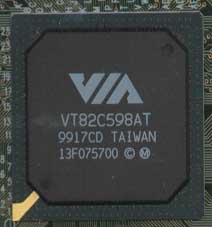 |
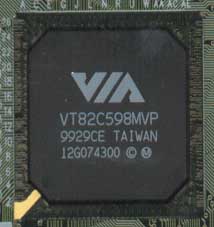 |
The Two North Bridges
A quick email off to VIA asking to shed more light on the issue resulted in a confirmation that there are in fact two different North Bridge chips but nothing more than that, a tad disappointing, so we had to turn to other sources to look for an explanation...and we got exactly what we were looking for. It turns out that the current MVP3 chipset features a single North Bridge the VT82C598 and is manufactured under two different names depending on its final destination, with the 598AT being the OEM marking and the 598MVP being the marking used for retail distributors. Both markings are just that, markings, and aren't in any way related to the original MVP3 release. For whatever reason, VIA refused to explain this very simple situation to us, however now that it has been cleared up, the points against Tyan have been washed away.
The advantage is once again tossed to Epox due to their lower cost.
Ease of Setup/Configuration - Advantage Epox
| While the Tyan S1598 is aided by its superior User's Manual, the Epox G2 takes the lead in this category courtesy of a little acronym known as ESDJ, or Easy Set Dual Jumper. The ESDJ configuration on the Epox G2 is something that has been present on Epox boards for quite some time now (with the older boards it was a single jumper) and it allows for virtually the entire configuration of the CPU (with the exception of voltage settings) using two jumpers - one for the clock multiplier and the other for the FSB setting). The S1598, like all other Super7 solutions from Tyan, uses a much more complicated set of jumpers to configure your CPU and easily loses out to Epox in this category. While the G2 can set the clock multiplier and FSB using 2 jumpers, the S1598 uses a combination of 6 to accomplish the same task. |  |
| The voltage configuration is also much simpler on the Epox whose single set of dip switches do the same job as the 10-pin jumper block on the S1598. For a beginner, the G2 is much less intimidating and easier to configure than the S1598. Not to say that it can't be done on the Tyan, it's just more of a pain to do. More advanced users won't have a problem with this and will want to know the answer to the next question instead, What about Overclocking? | 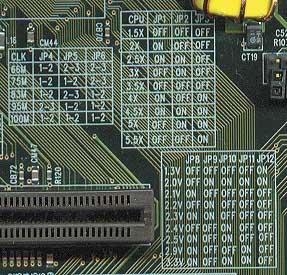 |
Overclocking - Advantage Epox
Overclocking on the Tyan? It's almost non-existent, there is always the option of overclocking via an increased clock multiplier (no Super7 CPU is clock locked) however in the case of all Socket-7 CPUs with the exception of the K6-III, an increased FSB generally has a greater effect on performance than an increased clock speed due to the frequency of the L2 cache being dependent on the FSB frequency. The lack of any FSB settings above 100MHz on the S1598 cripples Tyan's chances as an overclocker's dream, so what about Epox?
The G2 gives you the complete opposite, not only is the 112MHz FSB setting accessible via the FSB jumper of the G2's ESDJ but the Award BIOS setup contains an option to manually select the FSB from a list included overclocked as well as standard FSB settings. With the ease of setup and now the ease of overclocking in Epox's favor, it's not a surprise to see Epox gaining the advantage here.
Performance/Stability - Advantage Tyan
Here's the first point on Tyan's side of the court. With over 8 years of experience in manufacturing some of the highest quality workstation/server motherboards for the x86 platform, it is safe to say that Tyan knows a little bit about producing a stable motherboard solution. The S1598 is one of the most stable Super7 motherboards we have looked at to date, and although it still pales in comparison to the stability of Tyan's high end server motherboards it is definitely more than enough for your average user. The stability of the G2 was not horrible at all, in fact it takes a very close backseat to the S1598 and for average usage patterns the stability differences between the two are almost non-existent.
The performance argument is an entirely different one, according to Epox, slower memory timings and other such stability oriented optimizations keep the G2 from rising to meet the level of performance the S1598 offers right out of the box. Whether this is the case or not is up to Epox to explain, however the bottom line is that the S1598 is clearly the faster board out of the two and although we normally don't like to judge motherboards based on performance, there is a clear line of difference between the performance of the G2 and the S1598.
Added Features - Draw
While the Epox MVP3G2 stops at giving the user what they asked for, the Tyan S1598 goes above and beyond the call of duty to offer a unique feature that Epox didn't take into account. While both boards feature the standard Wake On LAN connectors and other such features that have since been made a part of the basic motherboard configuration, the S1598 adds support for a dual color ACPI LED which is another step closer towards what a truly PC'99 compliant motherboard will most likely offer as features in the next few months.
This feature is balanced out by Epox's support for a keyboard hot key that can power up the system courtesy of the ATX specification. While both of these features aren't the most commonly desired features, they are definitely appreciated as long as they don't increase the final cost to the consumer by a noticeable degree ;)
User Documentation/Software Bundle - Advantage Epox
In terms of Documentation, the S1598 wins hands down. The manual bundled with the G2 simply won't cut it as far as a thorough manual goes, however Tyan's S1598 manual is aided by useful pictures, mounds of helpful hints and information about the motherboard, and good information on the installation/configuration of the board as well.
Tyan loses what they gained in the Software bundle, as the CD bundled with the S1598 is nothing more than a drivers/utilities CD, which is expected from any motherboard manufacturer these days. However that's where Tyan's Software Bundle ends.
| Epox goes the extra mile by including a similar drivers/utilities CD-ROM but with one exception, the inclusion of a complementary copy of Symantec's Norton Anti-Virus as well as Ghost 5.1 (hard disk cloning software). While these two fringe benefits aren't requirements, they do tilt the balance of power in favor of Epox which seems to be the trend in this comparison. | 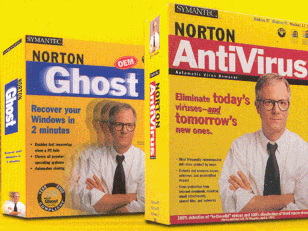 |
Cost/Availability - Advantage Tyan
Although the S1598 is the more expensive motherboard, the readily available Tyan brand gives it the advantage over the G2 in this category. What good is a motherboard if you can't find it to purchase? While the G2 doesn't fit into the "can't find" category, it is definitely a harder to find product than the Tyan board simply because Tyan is a much more of a recognized name in the industry.
Users on more of a budget will want to consider the Epox board, simply due to its lower cost, and with a bit of searching you should be able to find the board for order online.
The Score Board
So with all of that said and done, who is the winner? Let's go to the score board, each category counts equally and in the end the motherboard with the most points wins.
Super7 Head to Head Scoreboard |
||
Category |
Epox MVP3G2 |
Tyan Trinity S1598 |
| AnandTech Motherboard Rating | +0 | +1 |
| Layout | +1 | +0 |
| Memory Compatibility/L2 Cache | +0 | +0 |
| Chipset Configuration | +1 | +0 |
| Ease of Setup | +1 | +0 |
| Overclocking | +1 | +0 |
| Performance/Stability | +0 | +1 |
| Added Features | +0 | +0 |
| Documentation/Bundle | +1 | +0 |
| Cost/Availability | +0 | +1 |
| Totals | 5 | 3 |
The crowned winner is the Epox MVP3G2, while both boards were honorable competitors, in the end the Epox stepped away with the most points and is the crowned champ of this, our first, motherboard Head to Head. Till next time, enjoy.

